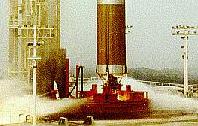rocket engines







|
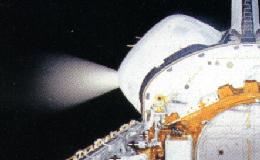 JOSEPH P. ALLEN, ENTERING SPACE |
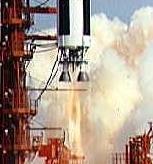 ASTRONAUTIX.COM |
This argument is based on the assumption that all hypergolic engines behave the same way. The lunar module ascent engine and the space shuttle RCS systems use different fuel. The space shuttle's RCS jets use monomethyl hydrazine (MMH). The lunar lander's ascent engine used Aerozine 50, a trade name for a half-and-half mixture of hydrazine and unsymmetric dimethylhydrazine (UDMH) developed for the Titan 2. The photograph above (right) shows a Titan 2 booster with its Aerozine 50 engines firing. In fact, once in operation the Aerozine 50 exhaust plume is essentially colorless and transparent.
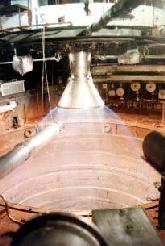 ARNOLD ENGINEERING DEVELOPMENT CENTER |
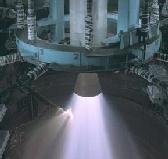 ARNOLD ENGINEERING DEVELOPMENT CENTER |
The photo on the far left is a rocket burning Aerozine 50 and nitrogen tetroxide, the exact mixture of propellants used on the lunar module's ascent and descent stages. The exhaust plume is nearly invisible.
In comparison the photo on the near left is a solid fueled rocket motor burning in the same test chamber, photographed from a slightly greater distance away. The plume is bright and opaque. Someone accustomed to the smoky, bright plumes of the Saturn V or the space shuttle is likely to be surprised by the clean pale plume of the Aerozine 50 engines.
Because the word "hydrazine" appears in the names of several fuels and also appears alone as a third type of fuel it's understandable that lay persons will confuse them, or assume they're largely the same substance. They aren't. Hydrazine, MMH, UDMH are significantly different in chemical formulation. The substances are related, of course, but not in visible combustion characteristics. We might draw a parallel between gasoline, kerosene, and diesel fuel. These are all hydrocarbons and share many chemical properties. But each has a unique combustion characteristic.
The visibility of the flame from hydrazine-type propellants depends on factors that include the precise form of hydrazine used, the design of the rocket motor, and the prevailing lighting conditions. The photograph of the shuttle's RCS plume was apparently taken with long exposure (note the visible stars in the background) and so may appear brighter in that photograph than if it were seen directly. The photographer intended to capture the RCS plume as the subject of his photograph and so adjusted his camera accordingly.
Some conspiracists point out that the film of the lunar module ascending from the lunar surface to meet the command module doesn't show any visible exhaust products. That's because by the time it comes into view of the command module the engine has stopped firing. Just as a baseball thrown upward will continue to rise after it has left the propulsive effect of your hand, the lunar module continues to rise after its engine stops firing. Unlike space ships in the movies, real spacecraft don't have to fire their engines continuously in order to make headway.
The flames from the steering jets don't generally show up on film because their plumes are too small, and also because the motion picture camera is not running at normal speed during the rendezvous. It's shooting only a few frames per second rather than the typical 24 fps in order to conserve film. Since the bursts from the lunar module with its RCS system in pulse mode would last only a few tenths of a second, it's likely that they'll happen between film frames if they were visible at all.
 We should see thick
smoke from the hypergolic engine of the lunar module ascent stage, as
in the above photograph of the Titan 2 launch.
We should see thick
smoke from the hypergolic engine of the lunar module ascent stage, as
in the above photograph of the Titan 2 launch.
Liquid-fueled rocket engines, including the hypergolic engines we are considering, often smoke during ignition and then burn very cleanly after liftoff. This is because the engines run roughly during the ignition process and then settle down into a steady state of operation. During this ignition transient unburnt propellants can be ejected from the nozzle as smoke. Similar "smoky" ignition transients can be observed in commercial jet engines and even some cars.
The duration of the ignition transient increases with the size and complexity of the engine. Large engines like the space shuttle main engines, with many internal pumps and turbines, take almost six seconds to reach steady-state operation. Small engines like the LM ascent engine with few moving parts reach steady-state operation in a fraction of a second and thus produce little if any smoke. Above is a Titan 3B rocket being launched, producing comparatively little smoke.
The conspiracist examples of hypergolic engine ignition and operation are always tests conducted in an atmosphere. For Aerozine 50 and nitrogen tetroxide this presents a special additional concern, since each of these chemicals reacts spontaneously with air. Nitrogen tetroxide produces an opaque orange vapor cloud on contact with air, and Aerozine 50 produces a white vapor cloud.
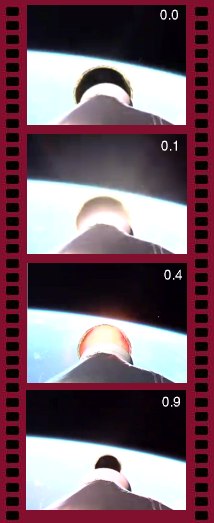 NASA: MARS ODYSSEY LAUNCH |
The video frames at right show the ignition of a Boeing Delta-II second stage, powered by an Aerojet AJ10-118K engine burning Aerozine 50 and nitrogen tetroxide. The engine shown is virtually identical in size and operation to the engine used as the descent stage motor on the Apollo lunar module.
The numbers in the upper right corner of each frame are the elapsed time in seconds between each video frame. From ignition to steady-state operation requires less than one second, produces no significant smoke, and the steady-state plume is invisible. This is how an Aerozine 50 engine normally behaves in a vacuum, and it is entirely consistent with the video footage of the lunar module liftoff.
The complete six-minute Real Video footage of this launch sequence is available from the Kennedy Space Center.
 The American flag was
planted very close to the spacecraft. Shouldn't the blast from the
ascent engine have burned it or knocked it down?
The American flag was
planted very close to the spacecraft. Shouldn't the blast from the
ascent engine have burned it or knocked it down?
The flag planted by the Apollo 11 crew was in fact knocked down as the ascent engine fired. This was not immediately reported to the public for sentimental reasons. NASA had not anticipated the difficulty of driving the flag pole deeply enough into the hard packed lunar soil.
The heat from the rocket exhaust would not ignite or scorch the flag. The lack of oxygen would keep it from burning. The exhaust gases from a rocket engine disperse rapidly in a vacuum, losing temperature and pressure in the process. By the time the exhaust gas reached the flag it would likely be too cold to cause visible damage.
 The spectacular film
footage of the Saturn rocket staging had to have been produced in a
studio. How else could you get such footage?
The spectacular film
footage of the Saturn rocket staging had to have been produced in a
studio. How else could you get such footage?
Engineers have been putting motion picture cameras in rockets for almost as long as they've been building rockets. When a rocket malfunctions, that footage is often the best means of determining what went wrong. It's an invaluable diagnostic tool.
Filming rocket operations is little different from filming events under other adverse conditions. The motion picture camera is enclosed in a housing which prevents it from being damaged. The camera is ejected as the spent rocket stage enters the atmosphere, and it falls back to earth either shielded by its housing or slowed by parachutes where it is recovered.
 NASA tested the Mercury
space capsules with animals. Why were no animals used to test the
Apollo spacecraft?
NASA tested the Mercury
space capsules with animals. Why were no animals used to test the
Apollo spacecraft?
The animal tests undertaken as part of the Mercury project were not intended to test the spacecraft so much as to test the behavior of complex organisms in space. At that time it was not known whether human beings could survive in zero gravity, or could survive the stresses of launch and landing. The animal tests proved that complex organisms like chimpanzees could survive launch and landing and happily work in space in the meantime, and so no further animal tests were needed.
The spacecraft hardware could be tested without having any live passengers. The telemetry technology was very limited during the Mercury project. By the Apollo era, lots of information was available to controllers on the ground via onboard sensors and telemetry, and so they could verify that the spacecraft was suitable for human use without needing to send biological specimens.
The Soviets sent live specimens into lunar orbit. This again was not so much to see if the spacecraft worked but to test the effects of radiation on living tissue. The United States also sent biological specimens into high earth orbit aboard smaller spacecraft in order to learn how the Van Allen belts and solar radiation would affect them.
